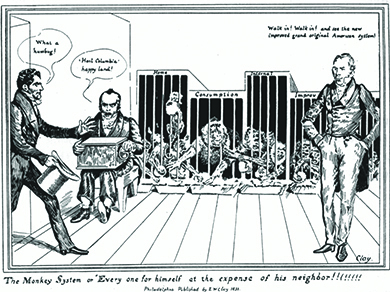| << Chapter < Page | Chapter >> Page > |
Visit the Cumberland Road Project and the Chesapeake and Ohio Canal National Historic Park to learn more about transportation developments in the first half of the nineteenth century. How were these two projects important for westward expansion?
Tariffs, which both Clay and Adams promoted, were not a novel idea; since the birth of the republic they had been seen as a way to advance domestic manufacturing by making imports more expensive. Congress had approved a tariff in 1789, for instance, and Alexander Hamilton had proposed a protective tariff in 1790. Congress also passed tariffs in 1816 and 1824. Clay spearheaded the drive for the federal government to impose high tariffs to help bolster domestic manufacturing. If imported goods were more expensive than domestic goods, then people would buy American-made goods.
President Adams wished to promote manufacturing, especially in his home region of New England. To that end, in 1828 he proposed a high tariff on imported goods, amounting to 50 percent of their value. The tariff raised questions about how power should be distributed, causing a fiery debate between those who supported states’ rights and those who supported the expanded power of the federal government ( [link] ). Those who championed states’ rights denounced the 1828 measure as the Tariff of Abominations , clear evidence that the federal government favored one region, in this case the North, over another, the South. They made their case by pointing out that the North had an expanding manufacturing base while the South did not. Therefore, the South imported far more manufactured goods than the North, causing the tariff to fall most heavily on the southern states.

The 1828 tariff generated additional fears among southerners. In particular, it suggested to them that the federal government would unilaterally take steps that hurt the South. This line of reasoning led some southerners to fear that the very foundation of the South—slavery—could come under attack from a hostile northern majority in Congress. The spokesman for this southern view was President Adams’s vice president, John C. Calhoun.
Vice President John C. Calhoun, angry about the passage of the Tariff of 1828, anonymously wrote a report titled “South Carolina Exposition and Protest” (later known as “Calhoun’s Exposition”) for the South Carolina legislature. As a native of South Carolina, Calhoun articulated the fear among many southerners that the federal government could exercise undue power over the states.
If it be conceded, as it must be by every one who is the least conversant with our institutions, that the sovereign powers delegated are divided between the General and State Governments, and that the latter hold their portion by the same tenure as the former, it would seem impossible to deny to the States the right of deciding on the infractions of their powers, and the proper remedy to be applied for their correction. The right of judging, in such cases, is an essential attribute of sovereignty, of which the States cannot be divested without losing their sovereignty itself, and being reduced to a subordinate corporate condition. In fact, to divide power, and to give to one of the parties the exclusive right of judging of the portion allotted to each, is, in reality, not to divide it at all; and to reserve such exclusive right to the General Government (it matters not by what department) to be exercised, is to convert it, in fact, into a great consolidated government, with unlimited powers, and to divest the States, in reality, of all their rights, It is impossible to understand the force of terms, and to deny so plain a conclusion.
—John C. Calhoun, “South Carolina Exposition and Protest,” 1828
What is Calhoun’s main point of protest? What does he say about the sovereignty of the states?
The early 1800s saw an age of deference give way to universal manhood suffrage and a new type of political organization based on loyalty to the party. The election of 1824 was a fight among Democratic-Republicans that ended up pitting southerner Andrew Jackson against northerner John Quincy Adams. When Adams won through political negotiations in the House of Representatives, Jackson’s supporters derided the election as a “corrupt bargain.” The Tariff of 1828 further stirred southern sentiment, this time against a perceived bias in the federal government toward northeastern manufacturers. At the same time, the tariff stirred deeper fears that the federal government might take steps that could undermine the system of slavery.

Notification Switch
Would you like to follow the 'U.s. history' conversation and receive update notifications?